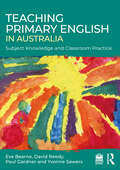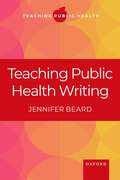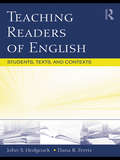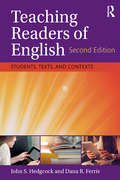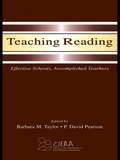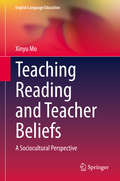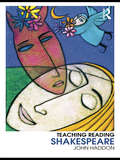- Table View
- List View
Teaching Poetry Writing: A Five-Canon Approach (PDF) (New Writing Viewpoints #2)
by Tom HunleyTeaching Poetry Writing: A Five Canon Approach is a comprehensive alternative to the full-class workshop approach to poetry writing instruction. In the five canon approach, peer critique of student poems takes place in online environments, freeing up class time for writing exercises and lessons based on the five canons of classical rhetoric: invention, arrangement, style, memory, and delivery.
Teaching Pragmatics and Instructed Second Language Learning: Study Abroad and Technology-Enhanced Teaching (Advances in Instructed Second Language Acquisition Research)
by Nicola HalenkoThis book explores second language pragmatic development with a specific focus on two areas: classroom-based pragmatic instruction in the study abroad context, and using technology for developing and assessing pragmatic competence. Teaching Pragmatics and Instructed Second Language Learning directly compares the effects of technology platforms and traditional paper-based tasks within the second language environment for developing pragmatic competence. These analyses are based on empirical research of how undergraduate Chinese learners of English receive explicit instruction in classrooms using different training materials. The book makes an original and innovative contribution to collecting oral speech act data in the form of computer-animated production tasks (CAPT) designed to enhance learner engagement and performance. Using this tool, it explores the beneficial role of technology in teaching and learning, offering practitioners and researchers practical ways to maximise second language pragmatic development in the classroom.
Teaching Pragmatics and Instructed Second Language Learning: Study Abroad and Technology-Enhanced Teaching (Advances in Instructed Second Language Acquisition Research)
by Nicola HalenkoThis book explores second language pragmatic development with a specific focus on two areas: classroom-based pragmatic instruction in the study abroad context, and using technology for developing and assessing pragmatic competence. Teaching Pragmatics and Instructed Second Language Learning directly compares the effects of technology platforms and traditional paper-based tasks within the second language environment for developing pragmatic competence. These analyses are based on empirical research of how undergraduate Chinese learners of English receive explicit instruction in classrooms using different training materials. The book makes an original and innovative contribution to collecting oral speech act data in the form of computer-animated production tasks (CAPT) designed to enhance learner engagement and performance. Using this tool, it explores the beneficial role of technology in teaching and learning, offering practitioners and researchers practical ways to maximise second language pragmatic development in the classroom.
Teaching Primary English: Subject Knowledge and Classroom Practice
by Eve Bearne David ReedyNow in its second edition, Teaching Primary English is a bestselling, comprehensive, evidence-informed guide designed to support and inspire teaching and learning in the primary school. Written in a clear and accessible way, it draws on the very latest research and theory to describe and exemplify a full and rich English curriculum. It offers those on teacher training courses, as well as qualified teachers who are looking to develop their practice, invaluable subject knowledge and guidance for effective, enjoyable classroom practice. Throughout there is an emphasis on equity and inclusion. Advice and ideas are supported by explicit examples of good teaching linked to video clips filmed in real schools, reflective activities, observational tasks and online resources. Each chapter includes suggestions for great children’s literature, considers assessment throughout and offers support in planning for inclusion and special educational needs. New and expanded areas for this edition include: Multimodal texts Increased coverage of Early Years Dialogic learning and oracy Comprehensive companion website with revised and additional resources A new section on digital literacies Reading for pleasure Teaching grammar in context Critical literacy With a focus on connecting all modes of English, the global and the local, and home and school experience, this detailed, uplifting book, includes inspiring case studies throughout and will support you in developing a curious, critical approach to teaching and learning English. Additional content can be found on the fantastic supporting website. Features include: Video clips from within the classroom to demonstrate English teaching techniques Audio resources, including an interactive quiz, to check understanding and provide real-life examples and case studies Downloadable resources to support teaching and incorporate into lesson plans.
Teaching Primary English: Subject Knowledge and Classroom Practice
by Eve Bearne David ReedyNow in its second edition, Teaching Primary English is a bestselling, comprehensive, evidence-informed guide designed to support and inspire teaching and learning in the primary school. Written in a clear and accessible way, it draws on the very latest research and theory to describe and exemplify a full and rich English curriculum. It offers those on teacher training courses, as well as qualified teachers who are looking to develop their practice, invaluable subject knowledge and guidance for effective, enjoyable classroom practice. Throughout there is an emphasis on equity and inclusion. Advice and ideas are supported by explicit examples of good teaching linked to video clips filmed in real schools, reflective activities, observational tasks and online resources. Each chapter includes suggestions for great children’s literature, considers assessment throughout and offers support in planning for inclusion and special educational needs. New and expanded areas for this edition include: Multimodal texts Increased coverage of Early Years Dialogic learning and oracy Comprehensive companion website with revised and additional resources A new section on digital literacies Reading for pleasure Teaching grammar in context Critical literacy With a focus on connecting all modes of English, the global and the local, and home and school experience, this detailed, uplifting book, includes inspiring case studies throughout and will support you in developing a curious, critical approach to teaching and learning English. Additional content can be found on the fantastic supporting website. Features include: Video clips from within the classroom to demonstrate English teaching techniques Audio resources, including an interactive quiz, to check understanding and provide real-life examples and case studies Downloadable resources to support teaching and incorporate into lesson plans.
Teaching Primary English in Australia: Subject Knowledge and Classroom Practice
by Eve Bearne David Reedy Paul Gardner Yvonne SawersThis first Australian edition of Teaching Primary English has been updated and adapted to reflect the Australian sociocultural and educational context. This text provides a comprehensive, evidence informed introduction to teaching and learning English in the primary school classroom. New content refers to the Australian English Curriculum and incorporates Aboriginal and Torres Strait Islander perspectives and literacy perspectives relevant to the Asia-Pacific region as well as the broader international context. This edition also includes a new section devoted to visual literacy, critical literacy and multimodality. Teaching advice and ideas are supported by practical examples linked to video clips filmed in real schools, reflective activities, observational tasks and online resources. Each section includes suggestions for great children’s literature and offers assessment advice and support for planning for diversity and special educational needs. Drawing on the very latest research and theory, supported by practical examples and guidance, this is an essential resource for pre-service teachers as they develop subject knowledge and the skills and confidence to deliver effective and engaging classroom practice.
Teaching Primary English in Australia: Subject Knowledge and Classroom Practice
by Eve Bearne David Reedy Paul Gardner Yvonne SawersThis first Australian edition of Teaching Primary English has been updated and adapted to reflect the Australian sociocultural and educational context. This text provides a comprehensive, evidence informed introduction to teaching and learning English in the primary school classroom. New content refers to the Australian English Curriculum and incorporates Aboriginal and Torres Strait Islander perspectives and literacy perspectives relevant to the Asia-Pacific region as well as the broader international context. This edition also includes a new section devoted to visual literacy, critical literacy and multimodality. Teaching advice and ideas are supported by practical examples linked to video clips filmed in real schools, reflective activities, observational tasks and online resources. Each section includes suggestions for great children’s literature and offers assessment advice and support for planning for diversity and special educational needs. Drawing on the very latest research and theory, supported by practical examples and guidance, this is an essential resource for pre-service teachers as they develop subject knowledge and the skills and confidence to deliver effective and engaging classroom practice.
Teaching Primary English through Drama: A practical and creative Approach
by Suzi Clipson-Boyles"The text is extraordinarily succinct, very well organised and highly readable. Each chapter examines in depth specific aspects of teaching and learning in drama and well-chosen practical examples can readily be adopted by teachers. A 'must' for all primary schools." Drama (the Journal of National Drama) Review of ‘Drama in Primary English teaching’ Teaching Primary English through Drama builds on the success of the classic text Drama in Primary English, inspiring ideas and techniques for teaching English skills through the medium of drama. Focusing on the power of drama to promote effective learning in primary education, Suzi Clipson-Boyles demonstrates how reading, writing, speaking and listening skills may be developed in ways that will motivate and engage pupils. She uses specific examples from the English curriculum, and also makes links to other areas of the curriculum. In addition, the book explains how assessment during drama can help teachers to evaluate pupils’ progress in English. Further guidance is given on how drama can enrich studying for pupils who are learning English as a foreign language. The book also provides a chapter on developing drama as an art form in its own right, with simple ideas and practical suggestions on how to enhance performances. Teaching Primary English through Drama presents a wide range of drama approaches from ten-minute starter activities to stimulate ideas such as fun ways to practise reading, through to longer projects that can provide contexts for extended writing or help with presentation and performance. The chapters show how drama can help to bring lessons alive in imaginative ways that not only promote enjoyment but also enhance achievement. This comprehensive and practical guide offers essential reading for primary teachers and other practitioners, and is a valuable resource to trainees. It also provides an excellent foundation for those who wish to extend their expertise further towards drama as a subject specialism.
Teaching Primary English through Drama: A practical and creative Approach
by Suzi Clipson-Boyles"The text is extraordinarily succinct, very well organised and highly readable. Each chapter examines in depth specific aspects of teaching and learning in drama and well-chosen practical examples can readily be adopted by teachers. A 'must' for all primary schools." Drama (the Journal of National Drama) Review of ‘Drama in Primary English teaching’ Teaching Primary English through Drama builds on the success of the classic text Drama in Primary English, inspiring ideas and techniques for teaching English skills through the medium of drama. Focusing on the power of drama to promote effective learning in primary education, Suzi Clipson-Boyles demonstrates how reading, writing, speaking and listening skills may be developed in ways that will motivate and engage pupils. She uses specific examples from the English curriculum, and also makes links to other areas of the curriculum. In addition, the book explains how assessment during drama can help teachers to evaluate pupils’ progress in English. Further guidance is given on how drama can enrich studying for pupils who are learning English as a foreign language. The book also provides a chapter on developing drama as an art form in its own right, with simple ideas and practical suggestions on how to enhance performances. Teaching Primary English through Drama presents a wide range of drama approaches from ten-minute starter activities to stimulate ideas such as fun ways to practise reading, through to longer projects that can provide contexts for extended writing or help with presentation and performance. The chapters show how drama can help to bring lessons alive in imaginative ways that not only promote enjoyment but also enhance achievement. This comprehensive and practical guide offers essential reading for primary teachers and other practitioners, and is a valuable resource to trainees. It also provides an excellent foundation for those who wish to extend their expertise further towards drama as a subject specialism.
Teaching Professional and Technical Communication: A Practicum in a Book
by Pam Estes Brewer Eva Brumberger Dave Clark Paul Dombrowski James M. Dubinsky Peter S. England David K. Farkas Brent Henze Tharon W. Howard Dan Jones Karla Saari Kitalong Traci Nathans-Kelly Christine G. Nicometo Kirk St. AmantTeaching Professional and Technical Communication guides new instructors in teaching professional and technical communication (PTC). The essays in this volume provide theoretical and applied discussions about the teaching of this diverse subject, including relevant pedagogical approaches, how to apply practical aspects of PTC theory, and how to design assignments. This practicum features chapters by prominent PTC scholars and teachers on rhetoric, style, ethics, design, usability, genre, and other central concerns of PTC programs. Each chapter includes a scenario or personal narrative of teaching a particular topic, provides a theoretical basis for interpreting the narrative, illustrates the practical aspects of the approach, describes relevant assignments, and presents a list of questions to prompt pedagogical discussions. Teaching Professional and Technical Communication is not a compendium of best practices but instead offers a practical collection of rich, detailed narratives that show inexperienced PTC instructors how to work most effectively in the classroom. Contributors: Pam Estes Brewer, Eva Brumberger, Dave Clark, Paul Dombrowski, James M. Dubinsky, Peter S. England, David K. Farkas, Brent Henze, Tharon W. Howard, Dan Jones, Karla Saari Kitalong, Traci Nathans-Kelly, Christine G. Nicometo, Kirk St.Amant
Teaching Proficiency Through Reading and Storytelling: An Input-Based Approach to Second Language Instruction (The Routledge E-Modules on Contemporary Language Teaching)
by Karen LichtmanThis module introduces Teaching Proficiency through Reading and Storytelling (TPRS), an input-based language teaching method. TPRS provides a framework for teaching classes completely in the target language—even those at the beginner level. Through the steps of establishing meaning, creating a story that is acted out live in class, and reading, students understand and use the target language to communicate right away. Research shows that over time TPRS creates fluent speakers who excel both on traditional tests and—more importantly—in real-life situations. This is a valuable resource on TPRS for world language teachers, language teacher educators, and second language researchers.
Teaching Proficiency Through Reading and Storytelling: An Input-Based Approach to Second Language Instruction (The Routledge E-Modules on Contemporary Language Teaching)
by Karen LichtmanThis module introduces Teaching Proficiency through Reading and Storytelling (TPRS), an input-based language teaching method. TPRS provides a framework for teaching classes completely in the target language—even those at the beginner level. Through the steps of establishing meaning, creating a story that is acted out live in class, and reading, students understand and use the target language to communicate right away. Research shows that over time TPRS creates fluent speakers who excel both on traditional tests and—more importantly—in real-life situations. This is a valuable resource on TPRS for world language teachers, language teacher educators, and second language researchers.
Teaching Public Health Writing (Teaching Public Health)
by Jennifer BeardClear, concise, engaging writing is critically important to public health practice. The Covid-19 pandemic has repeatedly thrown this fact into stark relief. No matter how hard we try, with the best intentions and evidence, public health professionals and researchers have struggled to communicate clear messages to the many audiences looking for information. The result has often been resistance, miscommunication, and deepening political division. Teaching Public Health Writing is a call to action for schools and programs of public health. Jennifer Beard, drawing on her interdisciplinary background in population health and the humanities, argues that writing practice and mentoring need to be central components of the graduate and undergraduate public health curriculum. Public health students are learning to translate complex technical content from a wide array of disciplines into engaging documents for vastly different audiences. This learning experience can be time-consuming and anxiety-inducing. Teaching Public Health Writing--the first book in the new Teaching Public Health instructor series--prompts educators at every level to rethink the place of writing in public health education. Using composition and public health theory, narrative examples, and detailed instructions from writing assignments used in public health classrooms across many disciplines and genres, Teaching Public Health Writing offers instructors a helpful guide to refresh or redesign in-course writing instruction and assignments. It ensures the next generation of public health professionals have the tools they need to communicate confidently and effectively.
Teaching Public Health Writing (Teaching Public Health)
by Jennifer BeardClear, concise, engaging writing is critically important to public health practice. The Covid-19 pandemic has repeatedly thrown this fact into stark relief. No matter how hard we try, with the best intentions and evidence, public health professionals and researchers have struggled to communicate clear messages to the many audiences looking for information. The result has often been resistance, miscommunication, and deepening political division. Teaching Public Health Writing is a call to action for schools and programs of public health. Jennifer Beard, drawing on her interdisciplinary background in population health and the humanities, argues that writing practice and mentoring need to be central components of the graduate and undergraduate public health curriculum. Public health students are learning to translate complex technical content from a wide array of disciplines into engaging documents for vastly different audiences. This learning experience can be time-consuming and anxiety-inducing. Teaching Public Health Writing--the first book in the new Teaching Public Health instructor series--prompts educators at every level to rethink the place of writing in public health education. Using composition and public health theory, narrative examples, and detailed instructions from writing assignments used in public health classrooms across many disciplines and genres, Teaching Public Health Writing offers instructors a helpful guide to refresh or redesign in-course writing instruction and assignments. It ensures the next generation of public health professionals have the tools they need to communicate confidently and effectively.
Teaching Readers in Post-Truth America
by Ellen C. CarilloTeaching Readers in Post-Truth America shows how postsecondary teachers can engage with the phenomenon of “post-truth.” Drawing on research from the fields of educational and cognitive psychology, human development, philosophy, and education, Ellen C. Carillo demonstrates that teaching critical reading is a strategic and targeted response to the current climate. Readers in this post-truth culture are under unprecedented pressure to interpret an overwhelming quantity of texts in many forms, including speeches, news articles, position papers, and social media posts. In response, Carillo describes pedagogical interventions designed to help students become more metacognitive about their own reading and, in turn, better equipped to respond to texts in a post-truth culture. Teaching Readers in Post-Truth America is an invaluable source of support for writing instructors striving to prepare their students to resist post-truth rhetoric and participate in an information-rich, divisive democratic society.
Teaching Readers of English: Students, Texts, and Contexts
by John Hedgcock Dana R. FerrisA comprehensive manual for pre- and in-service ESL and EFL educators, this frontline text balances insights from current reading theory and research with highly practical, field-tested strategies for teaching and assessing L2 reading in secondary and post-secondary contexts. Teaching Readers of English: provides a through yet accessible survey of L2 reading theory and research addresses the unique cognitive and socioeducational challenges encountered by L2 readers covers the features of L2 texts that teachers of reading must understand acquaints readers with methods for designing reading courses, selecting curricular materials, and planning instruction explores the essential role of systematic vocabulary development in teaching L2 literacy includes practical methods for assessing L2 students’ proficiency, achievement, and progress in the classroom. Pedagogical features in each chapter include questions for reflection, further reading and resources, reflection and review questions, and application activities.
Teaching Readers of English: Students, Texts, and Contexts
by John S. Hedgcock Dana R. FerrisA comprehensive manual for pre- and in-service ESL, EFL, and EIL educators who work with multilingual students at the secondary and postsecondary levels, this text balances insights from reading theory and research with highly practical, field-tested strategies for teaching and assessing second-language reading that educators can readily adopt and adapt to suit their contexts and student populations. Teaching Readers of English is a complete "go-to" source for teaching reading and promoting classroom and professional literacies in an increasingly digital world. Offering principled approaches and methods for planning and delivering effective L2 reading instruction, the text includes pedagogical features, such as questions for reflection, further reading and resources, and application activities to develop purposeful classroom reading lessons in a range of contexts. Changes in the Second Edition: Updated and revised chapters on formative and summative reading assessment, developing vocabulary knowledge and grammatical skill, and cultivating extensive reading and literary appreciation Updated information on institutional settings and reader demographics New pedagogical features in each chapter, including Chapter Summaries, Further Reading, Reflection and Review, and Application Activities A streamlined chapter sequence to enhance the text’s usability
Teaching Readers of English: Students, Texts, and Contexts
by John S. Hedgcock Dana R. FerrisA comprehensive manual for pre- and in-service ESL, EFL, and EIL educators who work with multilingual students at the secondary and postsecondary levels, this text balances insights from reading theory and research with highly practical, field-tested strategies for teaching and assessing second-language reading that educators can readily adopt and adapt to suit their contexts and student populations. Teaching Readers of English is a complete "go-to" source for teaching reading and promoting classroom and professional literacies in an increasingly digital world. Offering principled approaches and methods for planning and delivering effective L2 reading instruction, the text includes pedagogical features, such as questions for reflection, further reading and resources, and application activities to develop purposeful classroom reading lessons in a range of contexts. Changes in the Second Edition: Updated and revised chapters on formative and summative reading assessment, developing vocabulary knowledge and grammatical skill, and cultivating extensive reading and literary appreciation Updated information on institutional settings and reader demographics New pedagogical features in each chapter, including Chapter Summaries, Further Reading, Reflection and Review, and Application Activities A streamlined chapter sequence to enhance the text’s usability
Teaching Reading: Effective Schools, Accomplished Teachers
by Barbara M. Taylor P. David PearsonThis unique book tells the story of a select group of schools and teachers who have managed to beat the odds in terms of improving elementary students reading achievement. Originating with the CIERA School Change Project directed by Barbara Taylor and David Pearson, it was subsequently expanded to include the work of other research teams doing similar work. It combines large scale studies of effective schools and teachers (Part I) with case studies of individual schools and teachers who have successfully transformed research findings into situation-specific strategies appropriate to their schools and classrooms (Parts II and III). The book's distinct contribution is showing that no matter how consistent the research findings on effective school and classroom practice, groups of teachers must improvise their own situation-specific programs and practices. In short, they must be able to create variations on a common theme. Key features of this outstanding new volume include: *Integration of research and cases--One cannot fully understand research-based general principles without knowing how they play themselves out in specific settings. Similarly, one cannot fully understand cases without seeing the commonalities across different schools and classrooms sharing similar goals. This book provides both perspectives. *Diverse cases--The schools and classrooms depicted in this book are urban, rural, and suburban; poor and middle class; and English-only and bilingual. Rather than telling readers how to beat the odds, it provides them with a wide variety of cases from which they can extrapolate to build their own customized teaching programs and practices. *Summarizing section--The final section contains a summary of research on effective schools and teachers and a concluding chapter by Gerry Duffy and Jim Hoffman in which they reflect on the book's content and possible directions for future research. The book is targeted to both in-service elementary teachers and literacy students in advanced college courses.
Teaching Reading: Effective Schools, Accomplished Teachers
by Barbara M. Taylor P. David PearsonThis unique book tells the story of a select group of schools and teachers who have managed to beat the odds in terms of improving elementary students reading achievement. Originating with the CIERA School Change Project directed by Barbara Taylor and David Pearson, it was subsequently expanded to include the work of other research teams doing similar work. It combines large scale studies of effective schools and teachers (Part I) with case studies of individual schools and teachers who have successfully transformed research findings into situation-specific strategies appropriate to their schools and classrooms (Parts II and III). The book's distinct contribution is showing that no matter how consistent the research findings on effective school and classroom practice, groups of teachers must improvise their own situation-specific programs and practices. In short, they must be able to create variations on a common theme. Key features of this outstanding new volume include: *Integration of research and cases--One cannot fully understand research-based general principles without knowing how they play themselves out in specific settings. Similarly, one cannot fully understand cases without seeing the commonalities across different schools and classrooms sharing similar goals. This book provides both perspectives. *Diverse cases--The schools and classrooms depicted in this book are urban, rural, and suburban; poor and middle class; and English-only and bilingual. Rather than telling readers how to beat the odds, it provides them with a wide variety of cases from which they can extrapolate to build their own customized teaching programs and practices. *Summarizing section--The final section contains a summary of research on effective schools and teachers and a concluding chapter by Gerry Duffy and Jim Hoffman in which they reflect on the book's content and possible directions for future research. The book is targeted to both in-service elementary teachers and literacy students in advanced college courses.
Teaching Reading and Teacher Beliefs: A Sociocultural Perspective (English Language Education #20)
by Xinyu MoThis book explores language teacher beliefs in English as a Foreign Language (EFL) reading instruction in the context of Chinese university English instructors. Since the 1990s, there has been a renewed interest on teacher beliefs in the domain of language teacher cognition. However, most studies in this area aim at investigating the relationship between particular aspects of teacher beliefs and classroom practices, largely ignoring the complexity of teacher beliefs. This study explores the issue from an alternative perspective by conceptualizing teacher beliefs as a complex, dynamic and multi-faceted system. By adopting five rounds of interview and four classroom observations, the year-long study reveals seven key features of the belief system shared among six participants. It calls for the holistic, complex and insider view to examine teacher beliefs in relation to the sociocultural and historical contexts where the teachers work and live.
Teaching Reading and Writing Beyond High-stakes Testing: A Case Study of a High School Teacher in China
by Rongrong DongThis book tells about an exemplary high school Chinese language arts teacher’s effort in nurturing life-long readers and writers under the test-driven culture in China’s society. It looks closely at his everyday literacy practices, focuses on his ways of creating authentic reading and writing spaces for students beyond test preparation. With the lens of social constructivism, the case study reveals his efforts of creating safe learning environment, modeling his literate life, connecting real life with literacy learning and building a school-wide literate life for students. Furthermore, he also collaborates with other Chinese language arts faculty, reaches out to school administrators and educators to gain any potential teaching resource for students. The findings indicate exemplary teachers are not only equipped with professional knowledge but also inter/intrapersonal knowledge and practical knowledge in their teaching career, which might be enlightening in today’s high-stakes testing culture. The book will appeal to scholars of literacy education and teacher education, as well as pre-service & in-service teachers.
Teaching Reading and Writing Beyond High-stakes Testing: A Case Study of a High School Teacher in China
by Rongrong DongThis book tells about an exemplary high school Chinese language arts teacher’s effort in nurturing life-long readers and writers under the test-driven culture in China’s society. It looks closely at his everyday literacy practices, focuses on his ways of creating authentic reading and writing spaces for students beyond test preparation. With the lens of social constructivism, the case study reveals his efforts of creating safe learning environment, modeling his literate life, connecting real life with literacy learning and building a school-wide literate life for students. Furthermore, he also collaborates with other Chinese language arts faculty, reaches out to school administrators and educators to gain any potential teaching resource for students. The findings indicate exemplary teachers are not only equipped with professional knowledge but also inter/intrapersonal knowledge and practical knowledge in their teaching career, which might be enlightening in today’s high-stakes testing culture. The book will appeal to scholars of literacy education and teacher education, as well as pre-service & in-service teachers.
Teaching Reading Shakespeare
by John HaddonTeaching Reading Shakespeare is warmly and clearly communicated, and gives ownership of ideas and activities to teachers by open and explicit discussion. John Haddon creates a strong sense of community with teachers, raising many significant and difficult issues, and performing a vital and timely service in doing so. - Simon Thomson, Globe Education, Shakespeare’s Globe John Haddon offers creative, systematic and challenging approaches which don’t bypass the text but engage children with it. He analyses difficulty rather than ignoring it, marrying his own academic understanding with real sensitivity to the pupils’ reactions, and providing practical solutions. - Trevor Wright, Senior Lecturer in Secondary English, University of Worcester, and author of 'How to be a Brilliant English Teacher', also by Routledge. Teaching Reading Shakespeare is for all training and practising secondary teachers who want to help their classes overcome the very real difficulties they experience when they have to ‘do’ Shakespeare. Providing a practical and critical discussion of the ways in which Shakespeare’s plays present problems to the young reader, the book considers how these difficulties might be overcome. It provides guidance on: confronting language difficulties, including ‘old words’, meaning, grammar, rhetoric and allusion; reading the plays as scripts for performance at Key Stage 3 and beyond; using conversation analysis in helping to read and teach Shakespeare; reading the plays in contextual, interpretive and linguistic frameworks required by examinations at GCSE and A Level. At once practical and principled, analytical and anecdotal, drawing on a wide range of critical reading and many examples of classroom encounters between Shakespeare and young readers, Teaching Reading Shakespeare encourages teachers to develop a more informed, reflective and exploratory approach to Shakespeare in schools.
Teaching Reading Shakespeare
by John HaddonTeaching Reading Shakespeare is warmly and clearly communicated, and gives ownership of ideas and activities to teachers by open and explicit discussion. John Haddon creates a strong sense of community with teachers, raising many significant and difficult issues, and performing a vital and timely service in doing so. - Simon Thomson, Globe Education, Shakespeare’s Globe John Haddon offers creative, systematic and challenging approaches which don’t bypass the text but engage children with it. He analyses difficulty rather than ignoring it, marrying his own academic understanding with real sensitivity to the pupils’ reactions, and providing practical solutions. - Trevor Wright, Senior Lecturer in Secondary English, University of Worcester, and author of 'How to be a Brilliant English Teacher', also by Routledge. Teaching Reading Shakespeare is for all training and practising secondary teachers who want to help their classes overcome the very real difficulties they experience when they have to ‘do’ Shakespeare. Providing a practical and critical discussion of the ways in which Shakespeare’s plays present problems to the young reader, the book considers how these difficulties might be overcome. It provides guidance on: confronting language difficulties, including ‘old words’, meaning, grammar, rhetoric and allusion; reading the plays as scripts for performance at Key Stage 3 and beyond; using conversation analysis in helping to read and teach Shakespeare; reading the plays in contextual, interpretive and linguistic frameworks required by examinations at GCSE and A Level. At once practical and principled, analytical and anecdotal, drawing on a wide range of critical reading and many examples of classroom encounters between Shakespeare and young readers, Teaching Reading Shakespeare encourages teachers to develop a more informed, reflective and exploratory approach to Shakespeare in schools.



